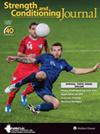限制血流的重复冲刺训练:提高重复冲刺能力的新方法?
IF 3
4区 医学
Q2 SPORT SCIENCES
引用次数: 1
摘要
团队运动运动员通常会进行重复的短时间冲刺(≤10秒),间隔短暂的恢复期(≤60秒)。在一系列冲刺中保持性能的能力称为重复冲刺能力(RSA)。RSA的生理限制因素包括力量生产能力下降、能量供应不足和代谢产物积累。这些限制因素可以通过重复的短跑训练来改善,在全身缺氧(即吸入氧气的比例减少)的情况下进行这种训练时,RSA会获得更大的收益。血流量限制(BFR)运动会导致局部缺氧和大量代谢产物负荷,这可能为改善RSA提供一种辅助训练方法。BFR训练可以增强肌肉力量和三磷酸腺苷的供应,这可能会提高随后的短跑成绩。改善有氧健身、磷酸肌酸再合成和BFR训练中代谢产物的去除也可以增强短跑之间的恢复,以抵抗疲劳。尽管重复的短跑BFR训练可以改善RSA,但目前还没有发表评论来整理这些信息。因此,本综述基于对重复短跑训练和BFR的生理影响的现有知识,为BFR训练如何对抗疲劳因素和提高RSA提出了一个理论框架。最后,将提供有关从业者如何实施BFR培训以改进RSA的指导。本文章由计算机程序翻译,如有差异,请以英文原文为准。
Repeated-Sprint Training With Blood Flow Restriction: A Novel Approach to Improve Repeated-Sprint Ability?
ABSTRACT Team sport athletes commonly perform repeated short-duration sprints (≤10 seconds) separated by brief recovery periods (≤60 seconds). The ability to maintain performance over a series of sprints is termed repeated-sprint ability (RSA). The physiological limiters of RSA include decreased force production capacity, insufficient energy supply, and metabolite accumulation. These limiting factors can be improved through repeated-sprint training, with greater RSA gains when performing this training with systemic hypoxia (i.e., reduced fraction of inspired oxygen). Exercising with blood flow restriction (BFR) causes localized hypoxia and a substantial metabolite load, which may provide an adjunct training method to improve RSA. Training with BFR augments muscular strength and adenosine triphosphate supply, which may improve subsequent sprint performance. Improved aerobic fitness, phosphocreatine resynthesis, and metabolite removal from BFR training could also enhance between-sprint recovery to resist fatigue. Despite the possible physiological benefits of repeated-sprint BFR training to improve RSA, there are no published reviews to collate this information. Therefore, this review proposes a theoretical framework for how BFR training could combat fatiguing factors and improve RSA based on current knowledge of the physiological impact of repeated-sprint training and BFR. Finally, guidance will be provided regarding how practitioners may implement BFR training to improve RSA.
求助全文
通过发布文献求助,成功后即可免费获取论文全文。
去求助
来源期刊

Strength and Conditioning Journal
社会科学-运动科学
CiteScore
4.70
自引率
8.00%
发文量
49
审稿时长
6-12 weeks
期刊介绍:
Strength and Conditioning Journal is the professional journal for strength coaches, personal trainers, physical therapists, athletic trainers, and other health professionals working in the strength and conditioning field. The journal’s mission is to publish articles that report both the practical applications of research findings and the knowledge gained by experienced professionals.
 求助内容:
求助内容: 应助结果提醒方式:
应助结果提醒方式:


